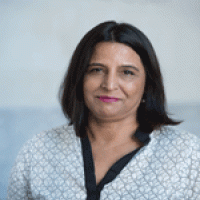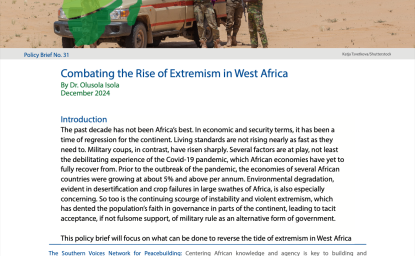Bombs and Burqas: Muslim Women and Extremism
We’re thrown off when women are drawn to religiously motivated violent extremism. We shouldn’t be.
We’re thrown off when women are drawn to religiously motivated violent extremism. We shouldn’t be.
It would be only a slight exaggeration to say that bombs and burqas have captured the world’s imagination when it comes to extremist terrorism. For some time now, we have been stunned by violent men engaged in horrific acts in the name of Islam and puzzled by women victimized in the name of Islam. So it is not surprising that when these two phenomena collide, in the form of a female suicide bomber or a husband and wife team that decide to engage in a deadly rampage against co-workers, as in the San Bernardino incident in California, we try to make sense of what we consider to be an incongruous, even shocking phenomenon.
Why are we particularly thrown for a loop by violent extremism among women? Is it because we see them as passive victims of their cultures and religion rather than active participants in it? The fact is that the Muslim world is experiencing as profound a gender revolution as anywhere in the world. When it comes to global gender dynamics, like women outnumbering men in higher education, or an increasing number of women participating in paid employment, Muslims are not significantly different from global trends.
When it comes to Muslim women’s participation in extremist groups we need to keep three dynamics in mind. First, women are crucial to the ideology and operation of militant networks. Though jihadi groups like Lashkar-e-Taiba (LET) tell women that their most important role is that of wives, sisters, and, most critically, as the mothers of future warriors, their aim is not to simply restore traditional gender roles. The women are advised to know what is going on in global political affairs and remain vigilant against attempts to take away their identity as Muslims by the seductive traps of fashion, consumerism, or status.
They are also told not only that their true place is within the chador and char-divari (in the home), but also that they are to actively manage the affairs of the home to rid it of fast-food, Coca-Cola, and the corrupting influence of television. They are to school their husbands and brothers on the seductions of the Internet and wean them away from the enervating pastime of watching cricket, that beloved sport of Pakistani males. Women are to make sure that the finances of the home are not corrupted by riba (interest, or usury). Thus, in all these ways, LET and similar groups assign a central role to women in what they see as a civilizational conflict against the West.
Marc Sageman’s research on jjihadi social networks similarly shows a pivotal role for women as the wives, sisters, and, less often, daughters of militants. There are instances, for example, where men join these groups after they marry a woman who is committed to the groups’ mission. More often, new recruits’ fidelity to the group is ensured through marriage to the sisters of other members. My own research on LET confirmed women’s central role in building familial ties between militants. There was no indication that women were forced into these marriages and there was substantial evidence that women came to the marriage already committed to the cause of jihad.
Second, we must pay attention to the class dynamics that are a subtle yet powerful undercurrent in the unfolding drama of women and extremist groups. In the summer of 2007, the streets of Islamabad saw burqa-clad, baton-wielding students of Jamia Hafsa engaged in vigilante actions, such as forcibly closing shops selling videos of ‘immoral’ Bollywood films, kidnapping a woman and accusing her of running a brothel, and taking Chinese women hostage for running a massage parlor.
The message was clear: the students of Jamia Hafsa, who came largely from impoverished families in the small towns and villages of Pakistan, were purifying the streets of Islamabad from what they saw as the moral corruption of the westernized Pakistani elite. For many of these young women, the possibility of taking part in any political action was non-existent until they joined Jamia Hafsa. What better way to avenge the daily indignities of marginal existence in a highly hierarchical place like Islamabad than to claim the moral high ground and assert the right to speak for the nation?
Third, it’s worth emphasizing that it is the adolescent desire for meaning and excitement that often attracts young people to extremist groups in Pakistan. Though undoubtedly these young students of Jamia Hafsa were manipulated by Umme Hassan, they were also empowered agents happily taking on the role of so-called ‘burqa avengers.’ They were energized by collective action like so many other young students who choose to take part in political protests. We should therefore not underestimate the lure of media coverage, the excitement of putting one’s life on the line, and, above all, the bravura of the young.
The young women of Jamia Hafsa found, in their roles as the ‘burqa avengers,’ an empowered sense of citizenship that otherwise eludes women from their socio-economic background. But for Tafsheen Malik, one of the San Bernardino shooters, it was not a lack of opportunities that turned her towards terrorism. As a new mother and wife, she does not fit our preconceptions of a terrorist. What we know now makes it clear that she actively sought a mate through an online matrimonial site who shared her warped outlook on what ailed the contemporary Muslim world.
What we do not know yet is who or what was responsible for her turn towards extremism before she sought a like-minded husband on a matrimonial site. According to her professors, Tafsheen Malik was a bright and diligent student of pharmaceuticals at Bahauddin Zakariya University in the southern Pakistani city of Multan. Her path to radicalization may resemble that of the the 16-year-old Khadiza Sultana, who left her East London home with her two friends to join the Islamic State in the summer of 2015. Khadiza, described as an exceptionally bright student, was expressing her rebelliousness by adhering to a counter-culture of extreme religiosity. According to the New York Times, in the social milieu that Khadiza and her two friends occupied, “Islam is punk rock. The head scarf is liberating. Beards are sexy.”
With a slight change in the trajectory of Khadiza Sultana’s life, she could have thrown herself into saving the world from climate change or protesting the greed of large corporations. Malik, who was also known as the ‘Saudi girl’ because of her upbringing in the Kingdom and her strict veiling practices, actively curated her lifestyle choices around a political statement. In order to counter the dynamics that produced Tafsheen Malik, Khadiza Sultana, and others like them, we must move away from the stereotype of Muslim women as passive victims and recognize that women, as much as men, may have a variety of misguided reasons to join extremist groups.
This article originally appeared on The Diplomat.


The Indo-Pacific Program promotes policy debate and intellectual discussions on US interests in the Asia-Pacific as well as political, economic, security, and social issues relating to the world’s most populous and economically dynamic region. Read more


The Wilson Center’s Middle East Program serves as a crucial resource for the policymaking community and beyond, providing analyses and research that helps inform US foreign policymaking, stimulates public debate, and expands knowledge about issues in the wider Middle East and North Africa (MENA) region. Read more


